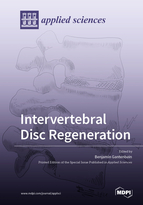Intervertebral Disc Regeneration
A special issue of Applied Sciences (ISSN 2076-3417). This special issue belongs to the section "Applied Biosciences and Bioengineering".
Deadline for manuscript submissions: closed (28 February 2021) | Viewed by 26170
Special Issue Editor
Interests: hydrogels; progenitor cells; regeneration; tissue engineering; bioreactors; mechanobiology; anterior cruciate ligament; cartilage; intervertebral disc; bone
Special Issues, Collections and Topics in MDPI journals
Special Issue Information
Dear Colleagues,
The healthy spine is the backbone of each individual but also for our entire society. Discogenic back pain is a major burden on the global scale. Degeneration of the intervertebral discs (IVD) of the spinal column represents a major challenge for successful biological and tissue-engineered treatments. Alternatives to the surgical “gold standard”, which is discectomy followed by spinal fusion, are urgently warranted. This Special Issue calls for recent advances in approaching regeneration of the IVD using a combination of biomaterials with or without cells. Some of our focus will be on the search for ideal cell sources for cell therapy and bioactive compounds or manipulation (e.g., growth factors, peptides, gene therapy). Due to the nature of the IVD, it is important to distinguish between repair of the outer ring, i.e., the annulus fibrosus, and of the center, i.e., the nucleus pulposus. These two different tissue types require each a different strategy and likely require composite materials for a combined repair. Clinical translation of cell therapy seems challenging as a reliable cell source is essential, and the fate and effects of transplanted cells are often difficult to track. The Special Issue calls for recent advances in the field of regeneration for the IVD of the spinal column.
Prof. Dr. Benjamin Gantenbein
Guest Editor
Manuscript Submission Information
Manuscripts should be submitted online at www.mdpi.com by registering and logging in to this website. Once you are registered, click here to go to the submission form. Manuscripts can be submitted until the deadline. All submissions that pass pre-check are peer-reviewed. Accepted papers will be published continuously in the journal (as soon as accepted) and will be listed together on the special issue website. Research articles, review articles as well as short communications are invited. For planned papers, a title and short abstract (about 100 words) can be sent to the Editorial Office for announcement on this website.
Submitted manuscripts should not have been published previously, nor be under consideration for publication elsewhere (except conference proceedings papers). All manuscripts are thoroughly refereed through a single-blind peer-review process. A guide for authors and other relevant information for submission of manuscripts is available on the Instructions for Authors page. Applied Sciences is an international peer-reviewed open access semimonthly journal published by MDPI.
Please visit the Instructions for Authors page before submitting a manuscript. The Article Processing Charge (APC) for publication in this open access journal is 2400 CHF (Swiss Francs). Submitted papers should be well formatted and use good English. Authors may use MDPI's English editing service prior to publication or during author revisions.
Keywords
- biomaterials
- tissue engineering
- nutrition
- organ culture
- progenitor cells
- cell therapy






